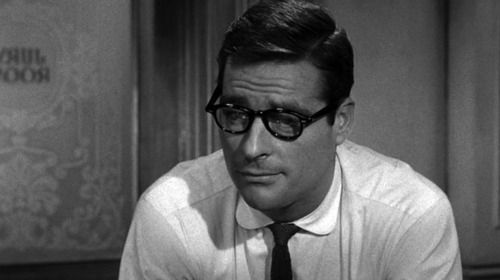
“What’s the point of having witnesses at all!”
Robert Webber as Juror #12 is the guy who many of us must admit that we would be in a similar situation. He genuinely wants to do the right thing, but he honestly can’t figure out what that is. This second-rate Don Draper is far more comfortable making decisions when the stakes aren’t so high and when a dopey joke can win the day. Webber’s well-placed idiosyncrasies take one of the characters with a less central role and gives him a variety and depth that could easily have been missing.
Robert Webber was born in Santa Ana, California in 1924, the son of a merchant marine. He served his own stint in the armed forces during World War II, as a Marine on Guam and in the fighting on Okinawa, where more men died than in any other Pacific battleground. Participating Americans called Okinawa “hell’s own cesspool,” and “the most awful place conceivable.”
Once the war was over, Webber reportedly hitchhiked to New York City to begin his acting career, quickly finding his way onstage on Broadway.
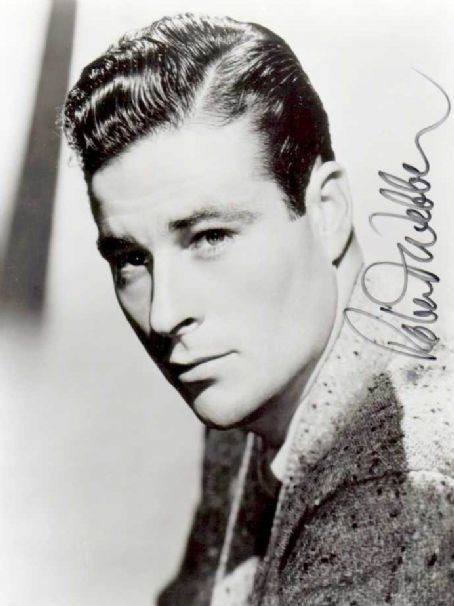
Webber trod the boards in productions like “Two Blind Mice” and “The Royal Family.” He also began appearing on television, in both “The Philco-Goodyear Television Playhouse,” and “Starlight Theatre.”

Webber’s first film role was as one of a group of well-dressed criminals, robbing banks and gunning folks down through Maryland, Virginia, and North Carolina in “Highway 301” (1950). The above publicity photo shows Webber with co-star Virginia Grey.
Continued television work in “Out There,” “Studio One in Hollywood,” and “Robert Montgomery Presents” kept Webber going, but a bigger break was getting cast in the Broadway production of “No Time For Sergeants” alongside Andy Griffith, Don Knotts, and Roddy McDowall. Webber was part of the opening night cast for the hit show, which ran for 2 solid years.
His next job was the one which would be his most memorable for many cinephiles. He joined the film version of Reginald Rose’s jury room drama “12 Angry Men” as a conflicted ad man sorting through the details of what initially seems like an open-and-shut murder case.
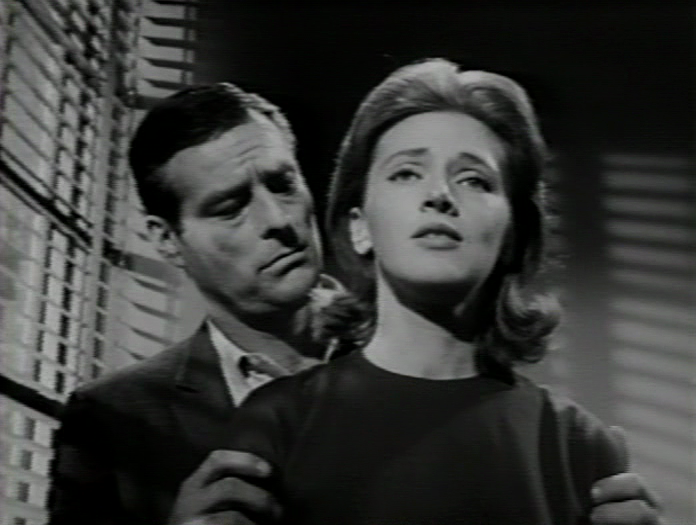
The film’s poor performance at the box office appears to have relegated Webber to the television roles he had already been getting, as he spent six more years mostly showing up in programs like “The Phil Silvers Show,” “New York Confidential,” and “The Rifleman.” He also collaborated with “12 Angry Men” co-stars E.G. Marshall and Edward Binns on their television shows “The Defenders” (above) and “Brenner.”
In December of 1964, Webber appeared in a well-known episode of the television sci-fi anthology series “The Outer Limits,” as Ikar, an alien who trades advanced scientific data for a human scientist’s emotions. The usual conundrums ensue. The episode, named “Keeper of the Purple Twilight,” is the sort of thing that Mad Men’s Ken Cosgrove would probably write. Check out a scene from it below:
By this point in the episode, Webber had transformed into one of those hulking aliens who appear in this poor guy’s office.
1965 brought Webber a starring role in the Hammer films noir mystery “Hysteria.” He plays an amnesiac who is trying to solve a bizarre murder case. Is he mentally unstable? Is he seeing things that aren’t there? Or is he just a little hysterical?
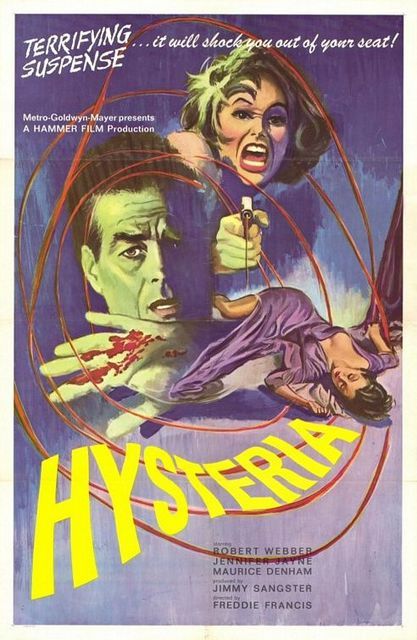
Another big break was in the awful Richard Burton/Elizabeth Taylor romantic vehicle “The Sandpiper” as Ward Hendricks, an ex-lover of the Taylor character. My parents love the film based almost entirely on its soundtrack and the photography of its Big Sur settings. Apparently they spent some time there when they were a young married couple living in the Monterey area. I personally find the movie unbearable.

Webber had some good luck in 1966, appearing in supporting roles in back-to-back #1 box office hits. First, as killer Sam Gunther in “The Silencers.” He hardly appears in this trailer for the Dean Martin 007 ripoff, but the pure mid-60s cheesy awesomeness contained here makes it well worth the watch.

Then, as a slithering sadist in the Paul Newman vehicle “Harper.” Neither role was a rocket to stardom for Webber, but you have to figure #1 hit films are pretty much always a good thing.

Webber’s next project could’ve feasibly traded titles with “12 Angry Men.” Unfortunately, this time around he doesn’t get to play one of the title eggs. 1967’s “The Dirty Dozen” is widely considered to be one of the great “Guy” flicks of all time. Despite many objections to the violence contained in the movie, it ended up being the fifth highest grossing picture of the year. Webber plays one of the senior officers who organize a pre-D-Day operation using just twelve U.S. Army convicts.
Film work remained steady, with parts in films like the Tony Curtis beach bum sex farce “Don’t Make Waves,” the French drama “Manon 70” starring Catherine Deneuve, and “The Big Bounce” with Ryan O’Neal and Lee Grant.
In 1970 Webber pitched in as a federal agent trying to take down the first black heavyweight boxing champion in “The Great White Hope.” James Earl Jones gives a towering performance that may surprise those who only know him as the voice of Darth Vader and from films like “Field of Dreams” and “Coming to America.” Webber once again brings nice nuance to what could be a pretty thankless role.

He continued to cultivate his waspy tough guy credentials in 1974’s Sam Peckinpah flick “Bring Me the Head of Alfredo Garcia.” Webber plays a gringo hit man so cold that he knocks a bar girl out with his elbow for coming on to him during a business conversation (or is there a reason other than acumen?). But his best work is in a roadside scene when he pulls over to ask for directions. Hard men Warren Oates, Gig Young, and Kris Kristofferson are among those gunning it out over an award for the titular noggin. Oates carries the proceedings with his western noir delivery, looking and sounding like a character out a Tom Waits song. While the film can be quiet and a little ponderous, when the bullets fly, they come in shocking fatal bursts. The promotional poster actually boasts about how many people are killed over the 2 hour running time, which is a nice public service, because I couldn’t keep track of it. Lots of guys fall down in slow motion after getting shot, I know that much.
Webber returned to consistent guest starring roles on television, in shows like “Cannon,” “The Streets of San Francisco,” “S.W.A.T.,” and “Police Woman.”
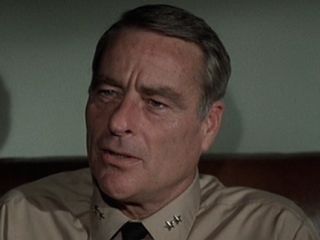
1976 saw Webber gracing the screen with “12 Angry Men” star Henry Fonda in the star-studded naval war film “Midway,” which ended up as the #10 box office hit of the year. It looks good on Webber’s resume, but his role is small, and frankly unless you’re a huge World War II buff it’s a little dull. Lots of stock footage.
In 1978, Robert Webber was cast as the primary heavy in the newest Pink Panther film, “Revenge of the Pink Panther.” While the final quarter of the original “The Pink Panther” is pure, wacky, genius, none of the Peter Sellers/Inspector Clouseau flicks maintains hilarity and a good forward momentum throughout. Each one, however, has individual moments which make the price of admission worth it.
Webber gets one of the funniest moments in “Revenge of the Pink Panther.”
This sixth installment (if you count the Alan Arkin “Inspector Clouseau” vehicle) begins as perhaps the best of the series, keeping the action and laughs coming at a good pace through its first 2/3. Unfortunately, a great premise collapses when A) Dyan Cannon is given too much to do B) the plot becomes too important and C) the gags start to fall flat.

Just the next year, Webber sidestepped his tough guy image by playing Dudley Moore’s homosexual songwriting partner and confidant in “10.” The film is famous for its objectification of Bo Derek as she runs on the beach with beads in her hair. The talented cast also includes Julie Andrews and Brian Dennehy, but “10” is an overlong sex romp with not quite enough romp. Despite its uneven quality, “10” turned out to be the 8th highest grossing film of 1979.

He showed up in another comedy star vehicle the next year in “Private Benjamin” with Goldie Hawn. Webber plays a paratrooper officer who is impressed by Benjamin’s performance in a war games exercise. “Private Benjamin” was a huge hit, holding the #1 box office slot for 8 consecutive weeks, and garnering 3 Academy Award nominations. Having just seen it, I have to shake my head in disbelief. It is an inoffensive little comedy, but it has very few laughs and its message of empowerment is unnecessarily muddy.
The next year, he again teamed up with director Blake Edwards on the Hollywood spoof S.O.B. which is best known as the film in which Mary Poppins went topless. This satire on the film industry sports an impressive cast that includes William Holden and Robert Preston (pictured), Richard Mulligan, Robert Vaughn, Larry Hagman, Loretta Swift, Rosanna Arquette, Shelly Winters, and Robert Loggia. Although critical reception was quite divided at the time of its release, S.O.B. a 100% “fresh” rating on Rotten Tomatoes.
Webber continued to work steadily, taking supporting roles in a long series of big screen offerings, including “Wrong Is Right” (1982) with Sean Connery, “Getting Physical” (1984) with David Naughton, and “Half Nelson” (1985) starring Joe Pesci. Unfortunately, none of these were big hits, and most can be identified as “B” features by just looking at the casts.

In 1986 he joined the cast of the popular Bruce Willis/Cybill Shepherd television program “Moonlighting” as Shepherd’s Father, with Eva Marie Saint as his wife. Webber only appeared in 6 episodes of the show, but was present for some of its more dramatic plot developments.

In the midst of filming these episodes, Webber also took a role in the Barbra Streisand ego project “Nuts” alongside Richard Dreyfuss, Eli Wallach, Karl Malden, Maureen Stapleton, and Leslie Nielsen. There’s a lot to recommend about “Nuts,” including the aforementioned supporting cast, but the psychology and law woven into the script is of the purely fictional variety, and well, most of the time I just can’t stand Streisand on screen. If you’re a fan of hers, you’ve probably already seen this flick. If not, you’d need to be impressed by that list of co-stars to make “Nuts” worth its while.
In the later years of his career, Webber seemed to age rapidly. This may have been due to him suffering from Amyotrophic Lateral Sclerosis (ALS), also known as Lou Gehrig’s disease. The motor neuron disease causes muscular atrophy globally, and can negatively affect speech, the swallow reflex, and breathing. While the individual’s physical abilities steadily decline, most retain their mental faculties until very near the end. ALS has been characterized as a very miserable existence, and we can only hope that each individual can be as comfortable as possible. Webber passed away due to the disease in 1989. He was only 64 years old.
Webber was a nicely naturalistic supporting player for most of his career, rarely nabbing the kind of roles that would garner critical praise, but always retaining the respect and confidence of the professionals around him. Having the opportunity to focus mostly on him when watching his films over the course of my research gave me an increased appreciation for his work. You’re watching a film with Robert Webber in it? If it’s not believable, it’s probably not his fault.
Read about all 12 Angry Men here-
Martin Balsam
John Fiedler
Lee J Cobb
E G Marshall
Jack Klugman
Edward Binns
Jack Warden
Henry Fonda 1
Henry Fonda 2
Joseph Sweeney
Ed Begley
George Voskovec
The post Juror #12: Robert Webber appeared first on Lebeau's Le Blog.
